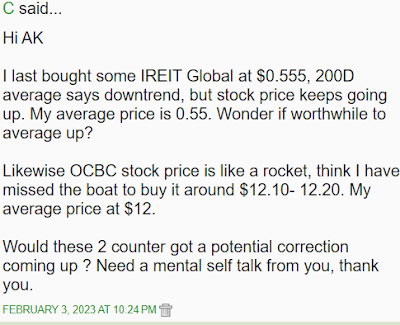Three signs of a banking crisis.
First is credit risk.
This is when loans turn bad and debtors are unable to make repayments.
Other assets can also turn bad and are unable to generate income required to make loan repayments.
We could see this playing out in the U.S. commercial real estate sector.
It also means it will be harder for certain borrowers to access credit.
Refinancing also becomes difficult as banks become more selective and risk averse.
Credit will tighten significantly as there will be heightened scrutiny of borrowers' credit worthiness.
Second is liquidity risk.
We might see withdrawals by depositors exceeding the available funds held by the banks.
This could lead to panic and runs on banks.
We saw this happened to Silicon Valley Bank in the U.S.A.
Later on, we also saw depositors withdrawing large amounts from First Republic Bank.
Even the $30 billion infusion provided by 11 big U.S. banks was insufficient.
Both S&P and Moody's downgraded First Republic Bank to junk.
Third is interest rate risk.
Rising interest rates reduce the value of long duration bonds held by banks.
This leads to weaker balance sheets.
In case many depositors need to make large withdrawals at the same time, banks might be forced to realize those losses by liquidating these long duration bonds.
Funding cost for banks can also rise further as they pay more to their depositors.
Funding cost could, in some instances, be higher than what banks receive in interest payments.
This could be the case if many long term loans on fixed rates were taken by the banks' customers before the interest rate hikes.
What is a systemic banking crisis?
A systemic banking crisis occurs when a large number of banks in a country have solvency or liquidity problems.
It could happen because of external shocks or because failure in one bank or a group of banks spreads to other banks in the system.
So, this explains why the U.S. regulators took over Silicon Valley Bank and Signature Bank very quickly.
It also explains why they moved to guarantee all deposits, even those larger than $250,000 insured under the F.D.I.C.
It was to prevent the failure of these two banks to spread to other banks in the system although in so doing, the U.S. regulators created a moral hazard as bad actors are not punished but bailed out.
Systemic banking crises are financial nightmares.
These crises often result in deep recessions for the countries concerned.
This is because banking crises usually affect consumer and business confidence.
Spending, investing and lending on all fronts reduce because of extreme fear.
Banking crises in major economies could also spread to other countries, resulting in a global banking crisis.
This is called a contagion.
This is why the Swiss authorities assigned partial blame for the collapse of Credit Suisse to the recent U.S. banking crisis.
After all, often, it is a crisis of confidence arising from heightened fear that is more damaging to the banking system and economy than any other crisis.
We could yet see Mr. Market going into another depression as an economic recession looks more likely now than ever to hit the U.S.A. in the not too distant future.
Recently published:
DBS, OCBC and UOB test supports. Bitcoin to $1m a coin?




























